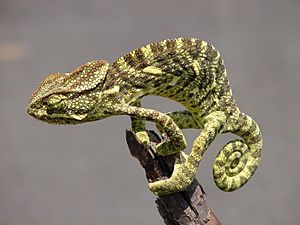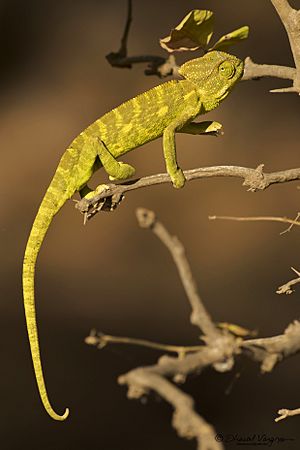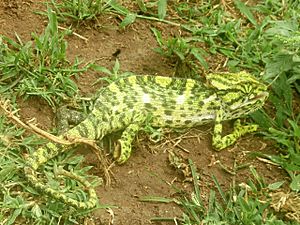Indian chameleon facts for kids
Quick facts for kids Indian chameleon |
|
|---|---|
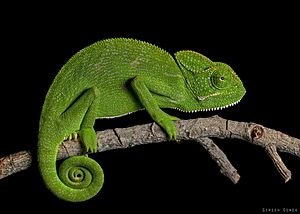 |
|
| from Kanakpura, Karnataka, India | |
| Conservation status | |
| Scientific classification | |
| Genus: |
Chamaeleo
|
| Species: |
zeylanicus
|
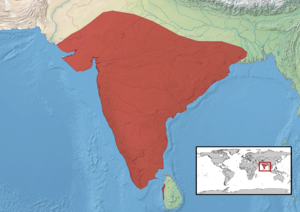 |
|
The Indian chameleon (Chamaeleo zeylanicus) is a type of chameleon found in countries like Sri Lanka, India, and Pakistan.
Like other chameleons, these amazing creatures move slowly. They often sway their bodies, which helps them look like a branch moving in the wind. This makes it harder for other animals to spot them! Indian chameleons usually live in trees.
They have a super long and sticky tongue. They can shoot it out to catch insects from far away. Imagine catching your dinner from several feet away with just your tongue!
Indian chameleons also have special feet that grip like tongs. They have a prehensile tail, which means they can use their tail to grab onto branches. Their eyes can move independently, so one eye can look forward while the other looks backward! They can also change their skin color and patterns very quickly.
Many people think chameleons change color to match their surroundings for camouflage. But that's not quite right for the Indian chameleon! They mostly change color to talk to other chameleons. For example, bright patterns can show a female is ready to mate. Darker colors might mean a chameleon is angry, wants to be left alone, or is showing it gives up in a fight. They also change color to control their body temperature. Darker colors help them soak up heat, and lighter colors help them cool down.
Contents
Where Do Indian Chameleons Live?
Indian chameleons live in many parts of India, especially south of the Ganges River. You can also find them in southeastern Pakistan and parts of Sri Lanka.
This is quite interesting because most other chameleons live in Africa, islands near Africa in the Indian Ocean, southern Europe, and the Arabian Peninsula. Scientists believe that Indian chameleons ended up so far away because their ancestors traveled across the ocean from Arabia a long, long time ago.
What Makes Indian Chameleons Special?
Indian chameleons have a unique head shape with a bony top. They have a special bone between their eyes. Their teeth are shaped like triangles and are quite sharp. They don't have teeth on the roof of their mouth.
Their eyes are big and covered by thick eyelids. There's just a small hole in the middle for the pupil. They don't have external ears. Their body is flat from side to side, and their neck is very short.
Their legs are long, which helps them stand tall. Their toes are grouped in a special way: three toes on one side and two on the other, like tongs. This helps them get a super strong grip on branches. As mentioned, their tail can grab things, too! Their skin is covered with small bumps or granules.
Males have a small spur or bump on their ankles. The tail of a male chameleon is usually longer than its head and body combined. The crests along their throat and belly are often white.
From the tip of their nose to the base of their tail, they can be up to 7 inches (18 cm) long. Their prehensile tail can be even longer, up to 8 inches (20 cm)!
Images for kids
See also
 In Spanish: Camaleón de la India para niños
In Spanish: Camaleón de la India para niños



